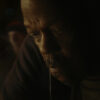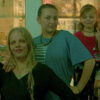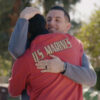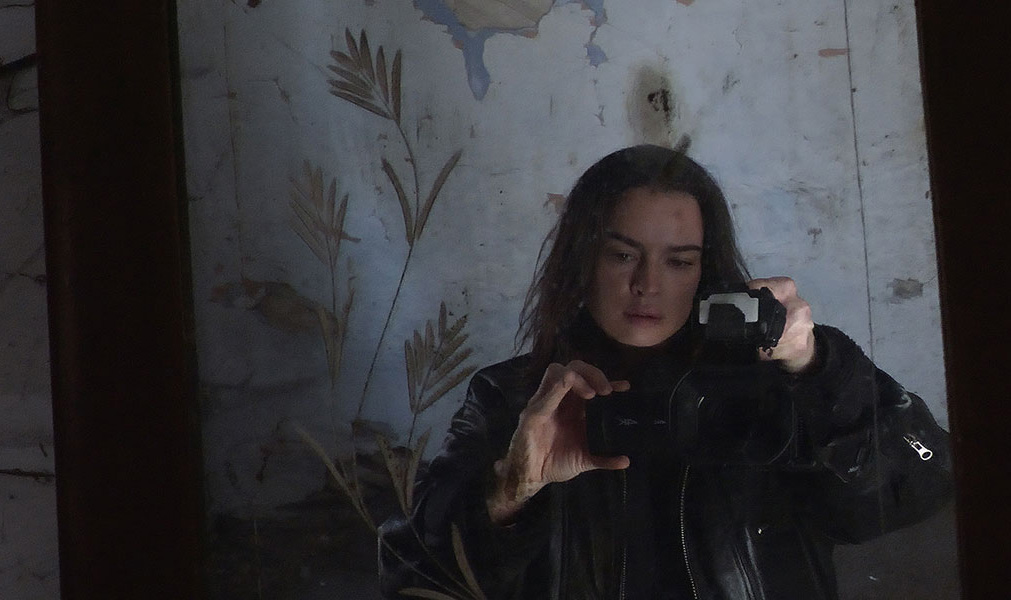“Why the barricades? I can’t understand it,” Kasia Smutniak can be heard asking as she attempts to make her way across the border between Poland and Belarus in “Walls,” an area that once had little surveillance, but with an influx of refugees has become a contentious territory with soldiers dispatched from both countries to patrol it. As part of the European Union, Poland has a mandate to offer the refugees asylum while Belarus left the consortium in 2021 in part to avoid any such obligation, yet Poland is hardly laying out the welcome mat either for those fleeing wartorn countries such as Syria and Ukraine, starting construction on a miles-long fence with funds that one has to wonder might be put to better use by simply offering humanitarian aid.
When Smutniak, who rose to fame in Italy as a model and actress but was born in Poland to a one-time Brigadier General in the Air Force, learned of the proposal to begin building this wall where there is already a bit of a natural demarkation point with the Białowieża Forest spanning nearly 353,000 acres, she set off for her grandmother’s house in 2022 with an Easter cake, a camera and her cinematographer Marella in tow. Although more used to being in front of the camera than behind it, what she captures in “Walls” is of considerable urgency as her own attempts to cross the hastily imposed checkpoints and borders reveals failures of both compassion and imagination when it comes to official government policy towards refugees, making the lives of those living around the borders equally untenable while highlighting the remarkable underground networks that have sprung up in support when larger organizations can’t be counted on.
While Smutniak’s passion comes through in “Walls” when she won’t be denied after encountering all the roadblocks in traversing her native Poland, the personalization of dealing with the logistics of travel proves to be just as illuminating when one of the ways she powers through the situation is to find the occasionally dark humor of it with Marella and constantly has to readjust plans on the fly, required to put her life in the hands of complete strangers without knowing for sure they’ve got her best interests at heart. When communication on cell phones relays one perilous event after another, the film extends the notion of being trapped from a geographic concern to a psychological one as fear of what happens at the border threatens paralysis, but when Smutniak pushes ahead, “Walls” becomes quite moving in other ways as a testament to the human spirit. Recently at the Toronto Film Festival for the film’s world premiere, Smutniak spoke about how she was motivated to make “Walls,” going about protecting anonymity while making sure history knows the names of the heroic and finding ways to blend cultures in the fabric of the film.
In the film, it appears you didn’t even give it a moment’s thought before picking up a camera and start shooting, given the urgency of the situation. Was the genesis of this really that fast?
This movie is not born by the need of making a movie as a director and trying to find a story that suits you. It was born out of the desperate need to tell this story. I started to follow the crisis on the Belarus border from the end of August 2021, just after the fall of Kabul, where the first group of 35 refugees was trapped in the forest. And even though they were asking for asylum in Poland, they were separated from everyone else. Activists, journalists, no one could get to them, not even to give them water, and that was the first time the barrier [between Belarus and Poland] started to show in Usnaż. They were trying to communicate only by waving hands or screaming something to the people that lived there and then eventually became activists.
I started to just follow that story on social media because there was not so much [coverage] in the newspapers, following these few reporters or journalists that were there just by their private accounts. This is how I learned also how to get the news that I need from the people that are on the ground. We’re overwhelmed with the news and not living in a historical moment where you will understand what is happening in the world by opening just one magazine in the morning with a coffee and a cigarette. That time is gone. Now you have to really search. Also the power of the information is so important [because] you don’t even know what is right and what is wrong, what is truth and what is not, so you really have to find a way to understand and follow the truth, so I got obsessed about that story. A few months later, I proposed to Diego Bianchi, a friend of mine who’s a reporter, to do a reportage for this Italian program called “Propaganda Live.” He’s been telling stories about refugees everywhere, and eventually the material that came out of our trip to Poland was a 50-minute reportage shown live on television and this is how the Italians got to know about the crisis there [in Poland]. So in that moment I understood how I could use my popularity [to share what’s happening], then it took me months [after] I came back to Italy and I was like a stalker to politicians, the chiefs of major humanitarian organizations like Amnesty International, UNICEF, Save the Children, Emergency. But no one was allowed to get into the [exclusion] zone.
Meanwhile, the Polish government settled the Red Zone all along the border [which] they call a dead zone, not only because people are dying, but because there is no information, and no politicians, humanitarian organizations or journalists were allowed to enter that zone. A few months later, the [Polish assembly] voted for building the wall [on the border] and then in 2022 the building of the wall started, so I was following that wall and [a film] just came to my mind because I was born in 1979, 10 years before the fall of Berlin Wall and I’m a product of that and I know I was lucky because I also know how easy it is to lose the freedom and what it actually means, even though I was a kid. So it was unthinkable for me that in my country, with such a story, we are building a wall and no one is talking about it.
One of the things that’s so striking to me in the film and seems to acknowledge how some people would rather not be identified while some do is how you present the names.
Giving names is [usually] a matter of what is legal and illegal and usually you should be happy to help people in the normal world. The world that I show on the Ukrainian side of the border where helping people is legal, so giving names to these people is like giving the glimpse of their story and I was trying to show what are the consequences of the choices when you’re forced as a citizen to make a choice. And [this] should not be up to you, just like I should not be telling this story. I expect politicians and journalists and reporters and people that have tools to tell this story, but no one was doing it, so I did, and these activists are just regular people that just couldn’t pretend that nothing is happening and they made a choice. There are consequences behind that choice, but none of them, none of them said, I regret what I’m doing.
So I wanted to show different types of activism. I have the Italian activist Silvia, who’s the only one that is an activist by choice and it’s her job. She’s taking it seriously, she [has] the tools she needs – emotional tools, political tools, and the structural tools – to do this as a job. But that’s her. I have Zosia, the girl who was never even on the border and I know that person longer than anyone else. I was in contact with her six months before, but never met. We were just on the phone sharing, like in a chat group, trying to give a hand to one refugee that was on the Polish border, but then they pushed him back many many times and then he was forced to go back to Iraq, so we were trying to somehow help him through the lawyers.
Your cinematographer ends up serving many roles on this, as much as part of the story as filming it. How did she get involved?
We met only a few years ago, and we clicked right away. She’s a great traveler, and she’s always positive, so I knew that she was the right person to join, and I needed the perspective of a person that doesn’t understand what is happening there because that is a point of view of someone watching this story not from Poland, and isn’t related to that history, still here to ask very simple questions, like, “Who are these people? What are we doing?” The first time we came to the activists‘ house, when we had all these backpacks and all the things for the saving people in the forest, [she’d ask] “What are all these things?” So it was something that people could relate to if they weren’t Polish and I think that bringing her point of view as a companion, someone that just joins the journey, was very interesting.
Something I found very powerful was a scene in which you use a camera drone to show the forest after you’ve been chased down by drones yourself. Was much thought put into using equipment that’s been weaponized?
We shot on drones before we were chased by the drones in the forest, and shooting a documentary, I had no plan, or I had a plan to tell the story about the world, but then the war started and I was preparing my luggage and I said, “What do I do now?” No one cares. And then more of my friends and relatives, and more of the whole of Europe [were conscious of the situation with] the Ukrainian refugees, and there was more of a contrast between the immoral and difficult situation that was happening on that other border. We’re talking about the borders that are in a straight line. So there’s 186 kilometers of the Polish-Belarusian border, and then it moves down, and it’s becomes a Poland-Ukrainian border, so it’s very, very close.
We’re talking about a small area where it became another wall, so when we decided to do it, I knew I couldn’t have any crew because it’s better just to travel really easily. I had just one chance and [although] the drone point of view is something that’s been used many, many times and probably better, it’s just my point of view of to see things from outside, finding the forest just as the Mediterranean Sea – something that you don’t know how to survive because it’s massive and you’re overwhelmed by. This forest is wild. There’s bison, there’s wolves, it’s overwhelming, it’s not just a forest. In fact, in Polish we have a specific word for it – “puszcza” – which means a massive land that is made like a forest. It is a specific place and it’s like the Mediterranean Sea where there’s no law written, but since thousands of years, once you see someone’s drowning, you have to save him. That’s the sea law and that is natural for everyone that lives around the sea. But we don’t have a law, so it’s your choice and if someone is not doing anything, you have to do it.
I’ve also been a pilot since I was 16, so that external point of view is something that is very close to me, but also it gives me a perception of something that is happening. It’s like an aquarium [where] it’s a different point of view, and you can get it only if you really fly over and you can see it from above and seeing from above, you’re not analyzing the what is happening there [now], but going back in time and analyzing our history. Then that’s why the story of the Litzmannstadt Ghetto is there. It’s all connected.
To extend the ocean metaphor a little further, the score for this is so buoyant, what was it like to put music on it?
The music process was the fun part. Together with Lorenzo Tomio, the composer, we worked a lot around the concept of creating one theme that would just change and switch because I wanted to connect different walls. [In the film] it’s a physical wall, then a natural geographic wall which is the forest, and then we also have the brick wall from the Jewish cemetery that that is the last part, [which is underscored by] a song made by Warsaw Village Band, which is really cool Polish band and they mixed traditional [music] with a lot of ethnic reggae and jazz – and Poland is jazz for me, so I was happy to connect it with with some cultural sounds. Then for the scene on the Ukrainian border, I had a chance to work with Eugenio Chiri, this incredible musician who lives in Italy and when I met him and I showed him the scene, it was a very special moment. The song has an incredible story. He’s Ukrainian and he recorded it with a Russian violinist, and the third musician is Italian, so I had these three people that were collaborating together and I think it has a great meaning.
That must be why it’s so rich and robust. What’s it like to start getting this out into the world?
I felt a bit detached from the situation [originally]. I said, “Okay, obviously I did it because I wanted to help, and even though it’s not immediate help, the extraordinary tool that we filmmakers have is to tell stories through emotions and there’s actually someone that listens to the stories, right? So that is very powerful – and that has no walls, no borders and no limits. No one can stop it. I shot it a year ago and I wanted out right away because I wanted to scream this out to the world. Then it took me nine months to do it, because [my first cut] was four hours, and my producer and friends said, “Kasia, it’s a movie.” And I [thought] let’s just put it on YouTube because it takes time to make a great movie. But they [said], “No, because if you do a movie, it has a chance actually to reach so many people.” And now here we are on the other side of the globe at the world premiere and yesterday I was thinking, “Okay, this is the moment. I did it, and now the word is spread. Now it’s up to the public,” and it’s really interesting as a process.
“Walls” does not have U.S. distribution.




